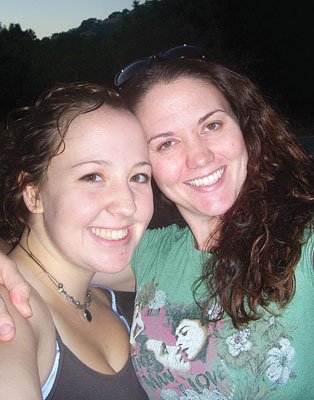Casey Johansen remembers the first time she was mistaken for a
middle-aged man. The mix-up, however, wasn’t due to the 22-year-old
Gilroy resident’s appearance. It was because of her illness.Full
article
Today’s breaking news:
Downtown lands right for boxing champ
Real vulture in this case is?
New principals, new budget woes for GUSD
Gilroy sales tax rises 7 percent
Casey Johansen remembers the first time she was mistaken for a middle-aged man.
The mix-up, however, wasn’t due to the 22-year-old Gilroy resident’s appearance. It was because of her illness.
Johansen, who has battled liver ailments since she was in elementary school, was attending a support group with her parents at the University of California, San Francisco Medical Center when a group leader walked up to her 56-year-old father, Bill.
They put their arms around him and said, “Hey Casey, it’s nice to meet you,” Johansen recalled, laughing.
Johansen, who has been diagnosed with primary sclerosing cholangitis, a disease that causes inflammation of the liver’s bile ducts, is a volunteer advocate for the California Transplant Donor Network. Johansen, who herself is in need of a transplant, said people often were surprised when she told them about her illness.
“It’s sort of thought of as a middle-aged man’s disease,” Johansen said. “They aren’t expecting a 20-something like me needing a liver transplant.”
Her mother, Gerra, said attempting to break that stigma has been a long process.
“There’s a lot of people like Casey that have never done drugs or drinking and through no fault of their own, need a transplant or they could die,” she said.
Johansen spoke at Monday’s Gilroy City Council meeting, urging residents to become organ donors as part of a monthlong effort by the Department of Motor Vehicles and Donate Life California asking citizens to agree to become organ donors when they apply for or renew their driver’s licenses.
Mayor Al Pinheiro announced a proclamation, naming April DMV/Donate Life Month in the city.
Advocating for organ donation hasn’t just been Johansen’s work. It’s been her life.
When she was 8 years old, she started getting stomachaches. Her parents thought she simply suffering from anxiety or possibly was intimidated by her new teacher. But Johansen gradually began to lose weight. Over several months, she went from a normal, healthy looking girl to “just skin and bones,” her mother said.
“I remember kids used to call me ‘the pregnant girl,’ ” Johansen said, referring to her waferlike body and her bloated, protruding stomach caused by malnourishment.
“She didn’t want to go into school and tell the students she was sick. But she went from being tall and thin to overweight,” her mother said. “The disease progresses so gradually we didn’t realize exactly what was wrong with her.”
After several months of testing, Johansen eventually was diagnosed with autoimmune hepatitis, a condition where the body treats the liver as a foreign object. Johansen remembered her liver became inflamed, not allowing it to absorb nutrients or function normally.
Once she was diagnosed, Johansen surrendered to steady doses of a steroid called predisone and other medications to regain weight. It worked, with one memorable side effect being the emergence of “chipmunk cheeks,” Johansen recalled.
Untreated, autoimmune hepatitis could have spelled a liver transplant, but Johansen stayed steady with her medication, keeping her condition in check as best she could.
“I was on and off those drugs for 10, 11 years,” she said. “I was really lucky. It was really well controlled.”
For years, Johansen lived what most people could consider a pretty average life. She played volleyball at Wilcox High School in Santa Clara and eventually played one year at Gavilan College.
She was often an honor student, and transferred to Gilroy High School, where she graduated in 2007. She rode horses and hiked Bay Area trails with friends.
“I was really lucky, I was always able to be a normal kid, a normal teen-ager,” she said. “I was able to do everything I wanted to do.”
Before she was out of high school, however, her health took another unwelcome turn.
“The summer before my senior year, I started having problems again,” she said.
Johansen was diagnosed with ulcerative colitis, an autoimmune disease that causes inflammation of the large intestine and colon. She had to submit to a special diet, which barred almost everything besides vegetables, meats and homemade butters and yogurts. She could slowly reintroduce other foods to her diet to see which ones caused her symptoms to flare up.
“It was very hard to maintain,” Johansen said.
Not to mention expensive, said her father Bill. His daughter’s current medications retail for roughly $2,000 per month, he said.
“All I need to say is thank God for insurance,” he said. “If we didn’t have insurance, I don’t know what we would have done.”
Six months of her new diet and medications finally controlled it. But another six months later, she again would face yet a new challenge.
Johansen, then 19, began battling sharp pains in her back. What she at first assumed was a kidney infection was something entirely different. It was then she was diagnosed with primary sclerosing cholangitis. Enter more medications and more suffering and frustration for Johansen, who was struggling to complete mundane and classroom activities at Mission College in Santa Clara.
“I started getting confused and disoriented in familiar places,” she said. “I had trouble keeping up with work, I was often fatigued.”
She didn’t know it at the time, but doctors soon would tell her she was headed toward complete liver failure. In July 2010, she was placed on an official transplant list.
Johansen, however, said she is “very low on the list.” She is sick, yes, but Johansen isn’t sick enough to rocket up the list any time soon, she said. She said she was told she could be on the transplant list for years.
In the United States, there are more than 16,000 candidates awaiting liver transplants, according to the Organ Procurement and Transplantation Network.
With a long, uncertain wait possibly looming for Johansen, her older sister, Autumn, made a heartfelt, yet risky proposition. She agreed to be her sister’s living donor, a process which takes part of a healthy person’s liver and transplants it into someone who is ill. She has started the application process to be a living donor, though doctors at UCSF will make the ultimate decision.
The best-case scenario is that both livers regenerate. The worst-case scenario is that one or both of the patients could die.
“Unfortunately you’re putting a healthy person at huge risks,” Johansen said.
Johansen said she’d like to pursue a career in public health, though she’s not sure exactly what career she’d like to hold. She is sure she’ll need a bachelor’s degree from a four-year college, and although she’s been accepted to San Jose State University and San Francisco State University, she’s holding off on school for now. Her symptoms have made it difficult for her to concentrate on schoolwork, but she’s hopeful she’ll still attend a university in the future.
“I’m not comfortable with the idea of spending all that money on classes and potentially fail,” she said. “For now, I’m putting it on hold. Not because I want to, but because I have to.”













